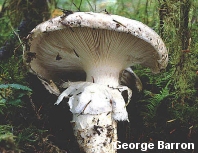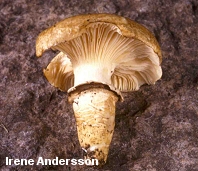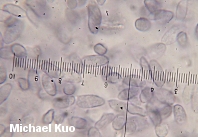| Major Groups > Gilled Mushrooms > Pale-Spored > Catathelasma |

About five species of Catathelasma have been described from North America. One of these, Catathelasma singeri, is a slimy, dull yellow mushroom found once near Aspen, Colorado, by Alexander Smith and other mycologists, who write: "All those who saw the fresh specimen supposed it to be an Hygrophorus. It was only when studied in the laboratory back in Ann Arbor that the significance of the specimen and its generic identity became apparent" (Mitchel & Smith, 1978; p. 1055). Other species include the imperfectly known Catathelasma evanescens (from Wyoming, with nearly distant gills and a volva-like veil) and Catathelasma macrosporum (also from the Rocky Mountains, with spores described at the turn of the 20th century as slightly wider than the spores of other species). The two "main" species, however, are keyed out below. Key to 2 Species of Catathelasma in North America
References Mitchel, D. H. & Smith, A. H. (1978). Notes on Colorado fungi III: New and interesting mushrooms from the aspen zone. Mycologia 70: 1040-1063. Singer, R. (1978). Keys for the identification of the species of Agaricales II. Catathelasma. Sydowia 31: 193-194. This site contains no information about the edibility or toxicity of mushrooms. Cite this page as: Kuo, M. (2006, October). The genus Tricholoma. Retrieved from the MushroomExpert.Com Web site: http://www.mushroomexpert.com/catathelasma.html © MushroomExpert.Com |


